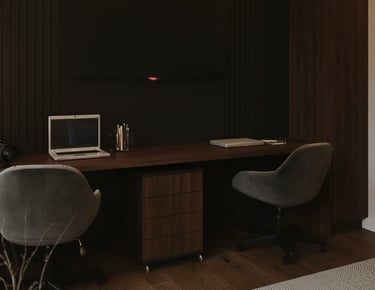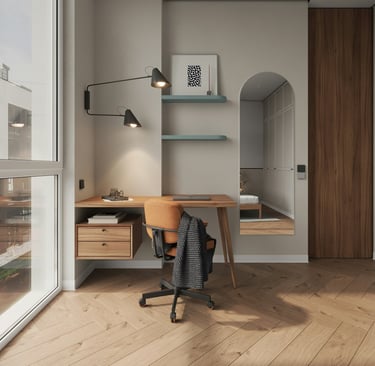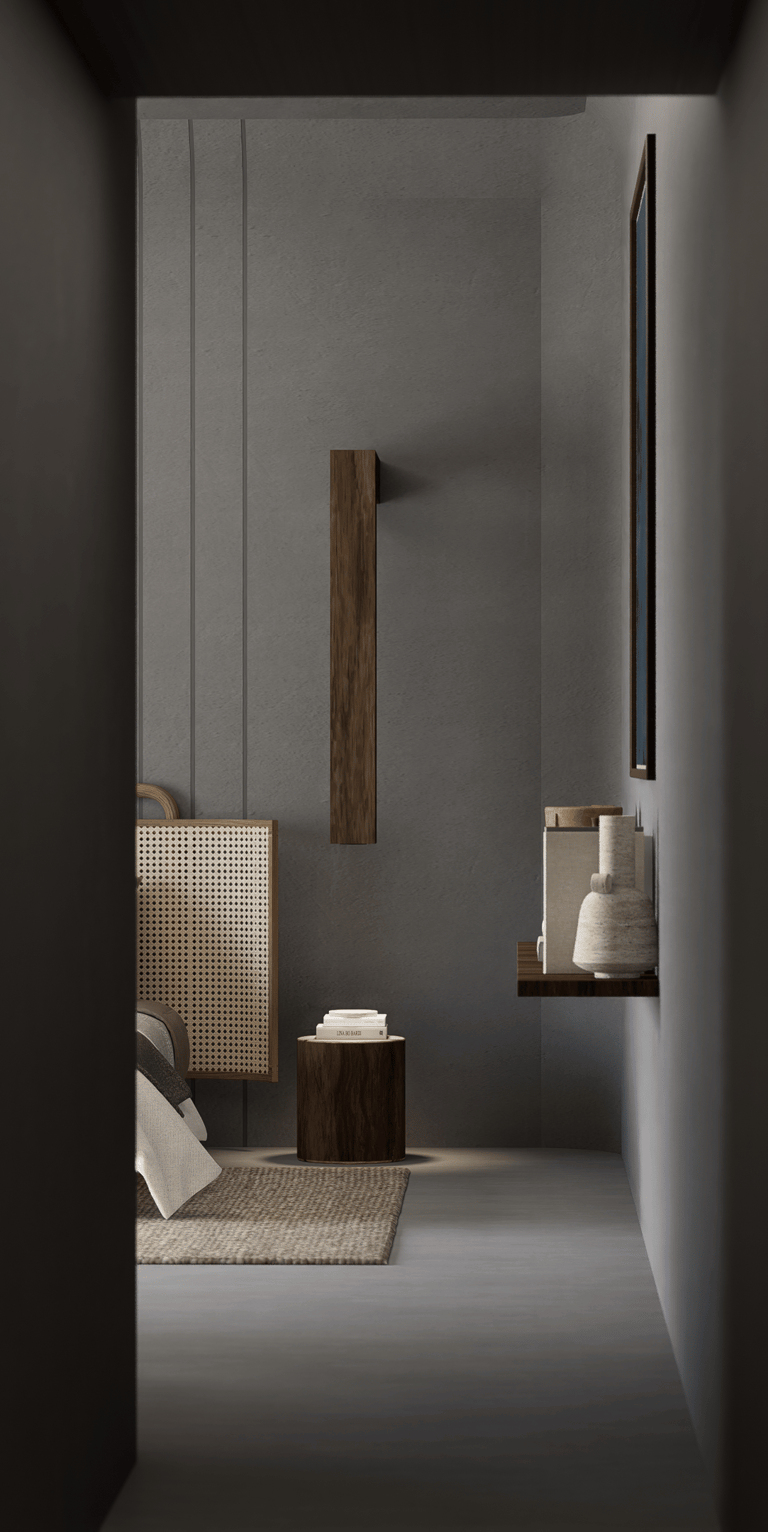Design Playbook: The Executive Home Office


Imagine walking into a villa office designed for influence and focus. Polished oiled-wood surfaces catch the soft morning light, while a backdrop of matte stone and bronze accents conveys quiet authority. A deep, recessed window frames the city skyline, letting daylight spill across a wool rug that tames sound and softens footsteps. Slatted timber panels, fabric-wrapped cabinetry, and concealed acoustic treatments create a space where conversation is clear and calm, even across hours-long work sessions.
Technology is integrated discreetly: cameras, lighting, and cables can be provisioned as needed, while remaining invisible when not in use. A secondary table sits nearby for sketches or printed documents, armless lounge chairs invite thinking without strain, and the air hums with subtle ventilation that disappears into the architecture. Every element, from furniture to finishes, from light to sound has been orchestrated to signal professionalism, comfort, and command.
This playbook identifies the pillars that define an executive suite designed for presence, privacy, and productivity.
The Acoustic Stage: Authority Begins with Sound
Acoustics is the first and most critical layer of an executive office. Authority begins with the sound of a voice—warm, intelligible, and free from echoes or low-frequency interference.
Isolation first: Doors with proper seals, weighted partitions, and attention to flanking noise prevent sound from sneaking through ceilings or corridors.
Controlled reverberation: Interiors should feel alive, not dead. Large upholstered panels, hidden behind slatted timber, fabric-wrapped cabinetry, or art, manage reflections discreetly.
Low-frequency absorption: Tuned traps can be integrated into wall reveals or cabinetry bases to absorb bass without visually disrupting the space.
HVAC design: Remote fan coils, low-velocity ducting, and careful pressure balancing prevent unwanted hums or whistling.
Surface choices: Rugs not only anchor furniture visually but dampen chair movement and footsteps, preserving acoustic comfort.
The result is an office where every spoken word carries clarity, and conversations, both virtual and in-person, feel effortless.
In the executive home office, light does more than allow you to see — it defines presence, mood, and how you appear to others. The right scheme ensures you look alert and composed on camera, while also making the room calm and usable off-camera.
Layered illumination: Instead of relying on a single ceiling fixture, lighting is composed in layers. A soft forward-facing light brightens the face naturally, while hidden fill lights gently dissolve shadows. A subtle glow behind the chair gives the impression of depth, separating you from the background in the way a professional studio would.
Avoiding harsh overheads: Ceiling spots alone can make even the sharpest features look flat or tired. Angled and concealed sources create dimension and warmth without glare, ensuring long hours never feel fatiguing.
True-to-life tones: Beyond brightness, quality matters. High-fidelity LEDs are chosen so that skin tones look healthy and natural, and the craftsmanship of cabinetry, leather, and art pieces reads exactly as intended. This is the quiet luxury of color accuracy — every detail rendered honestly.
Daylight under control: Large windows are a gift, but uncontrolled sunlight can bleach or distort. Sheer blinds filter midday brightness into a soft glow, while blackouts provide full control for video calls. Side lighting balances the screens, so there’s never a reflection across your face or desk.
Background as stagecraft: A carefully arranged backdrop — open shelves with a single sculptural object, a restrained artwork, perhaps a well-placed plant — creates a scene that communicates sophistication and focus without distraction. It is as considered as what you wear on screen.
Here, lighting is not just functional; it is compositional. It ensures you feel comfortable, look your best, and project authority — all without ever feeling “lit.”


Light That Performs: Daylight and On-Camera Illumination
Ergonomics: Luxury in Function
An executive villa office must sustain attention without demanding it. Ergonomic design translates into effortless daily performance:
Desk and monitor placement: Adjustable desks with monitors at eye level, keyboards and mice aligned for neutral elbows, and document surfaces within reach.
Secondary surfaces: Small adjacent tables support analog work—sketching, print review, handwriting—without interrupting digital workflow.
Seating: Task chairs with proper lumbar support are critical; armless lounge chairs may be seductive but can fatigue over hours.
Flooring: Dense wool rugs or high-quality weaves tame acoustics while providing visual calm.
Cable management: Wires routed invisibly protect the visual field and preserve mental clarity.
Every ergonomic decision reinforces a sense of control, reducing strain and elevating productivity.
Infrastructure as Silent Partner
The true luxury of a modern executive office is not in what you see, but in what you don’t. The technology is fully integrated, operating quietly in the background so the room feels effortless.
Networking that never falters
Instead of a single home Wi-Fi line, the villa office can be designed with dual high-speed internet providers working in parallel. If one drops, the other takes over instantly. Smart routers divide professional devices from personal ones, ensuring video calls never stutter because someone else is streaming.
Seamless video and audio
Cameras, lights, and microphones aren’t perched on desks or clipped to screens. They are built into cabinetry or recessed panels, designed with cooling systems so they never overheat or fail mid-call. To the user, it feels as natural as speaking in a perfectly lit room yet behind the scenes, it’s professional grade.
Power resilience
For a true executive, the office can’t go dark even for a second. Uninterrupted Power Supply systems (UPS) ensure computers, lighting, and communication tools continue running smoothly through brief outages. In practice, you won’t notice the lights flicker because the system simply holds the room steady.
Privacy and security as defaults
An executive office must do more than look impressive; it must protect what is said and what is stored. Privacy here is designed to be invisible yet absolute.
Acoustic calm: The room is engineered to absorb sound, so conversations never carry beyond its walls. This isn’t just insulation. It’s the difference between feeling exposed and knowing you can speak freely at any hour.
Intelligent blinds: Window treatments are automated to close at the touch of a button or on schedule, shielding both daylight glare and outside views. The result is focus, confidentiality, and control over the atmosphere.
Secure storage: Bespoke cabinetry includes discreet compartments for sensitive documents and personal effects. These are lockable yet seamlessly integrated into the design, ensuring security without disrupting elegance.
Peace of mind: Cameras and microphones, when present, are integrated unobtrusively and can be disabled instantly.
This invisible backbone allows the occupant to walk in, sit down, and perform at their best whether signing contracts, hosting a confidential board meeting, or taking a quiet moment to think. The infrastructure fades away, leaving focus and performance as the only experience.
Material Intelligence: Subtlety and Character
Luxury in a home office is tactile, visual, and understated:
Surfaces: Oiled woods, matte stones, and paper-wrapped drawers create warmth without glare.
Hardware: Bronze or brass pulls develop a rich patina, offering a daily sensory pleasure.
Shelving: Invites a curated collection of books, objects, or art; restraint conveys sophistication.
Colors: Minimalist palettes with warm neutrals maintain focus, while daylight-friendly tones support mood and energy.
Materials communicate quiet authority—they age gracefully, convey permanence, and reinforce the villa’s narrative of thoughtful craftsmanship.


Spatial Flow: Zones for Mind, Body, and Screen
A high-performance home office is spatially choreographed into distinct zones for maximum focus and comfort:
Task zones: These areas contain desks for digital work, tables for analog review, and spaces set aside for collaborative thinking. Each zone is placed to optimize lighting and minimize distractions.
Transition spaces: Short paths connect different zones. Changes in flooring, a plant beside the walkway, or a textured panel help define boundaries between areas. These transitions offer brief pauses and clear movement through the office.
Sensory anchors: Plants, textured cabinetry or surfaces for visual depth, a curated artwork for inspiration promote psychological comfort without distraction.
Thoughtful zoning allows the villa office to function as both a private sanctuary and a professional stage.
Closing Thought
The executive home office in a luxury villa is more than furniture and technology. It is a stage for authority, a sanctuary for focus, and a laboratory for creativity—all orchestrated with precision. Presence, privacy, and performance converge into a calm, practical luxury. Hours pass unnoticed; calls feel like conversations; decisions emerge effortlessly. In Dubai, where visibility and performance intersect, such an office is the ultimate signature of serious, considered living.


